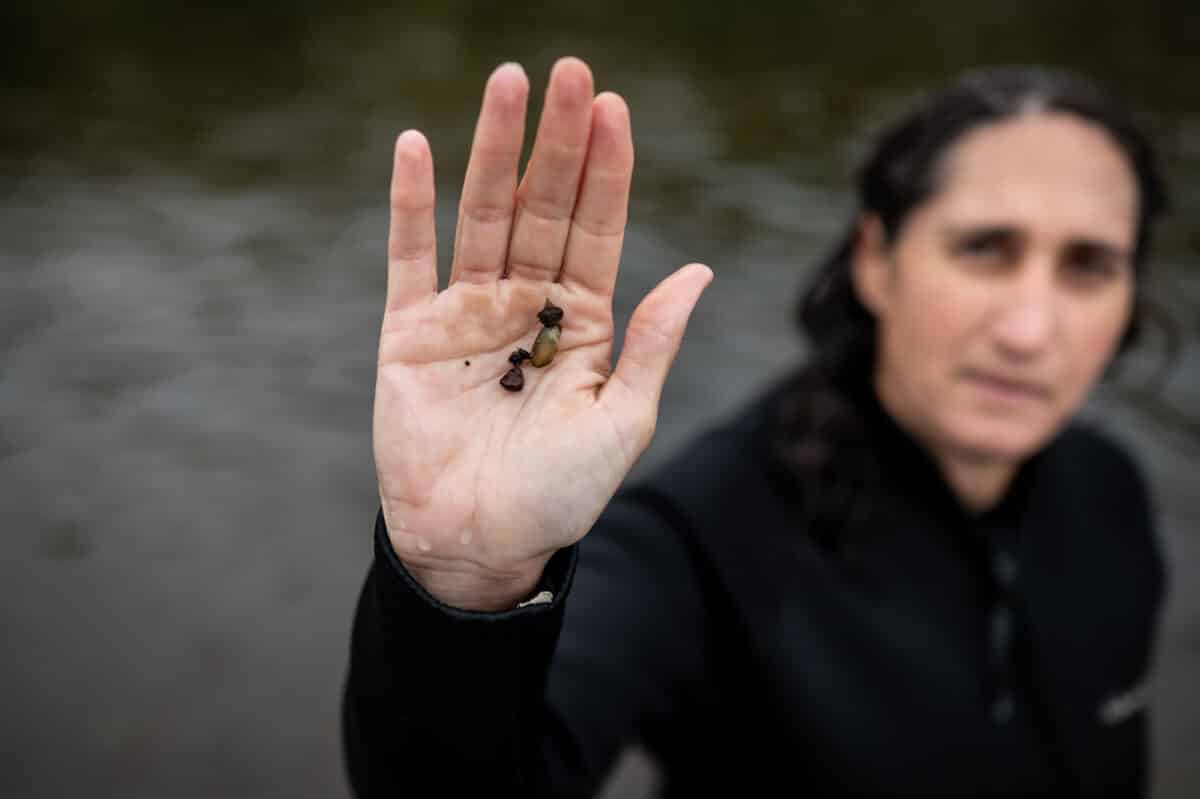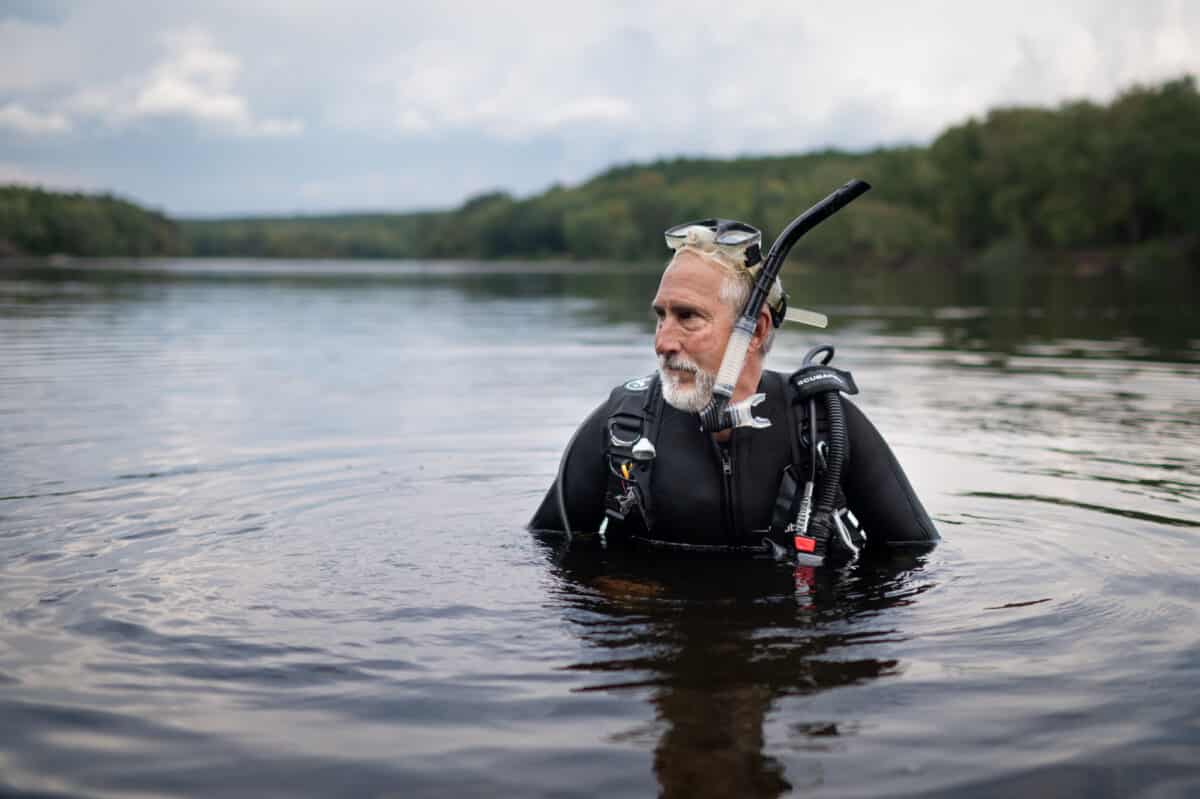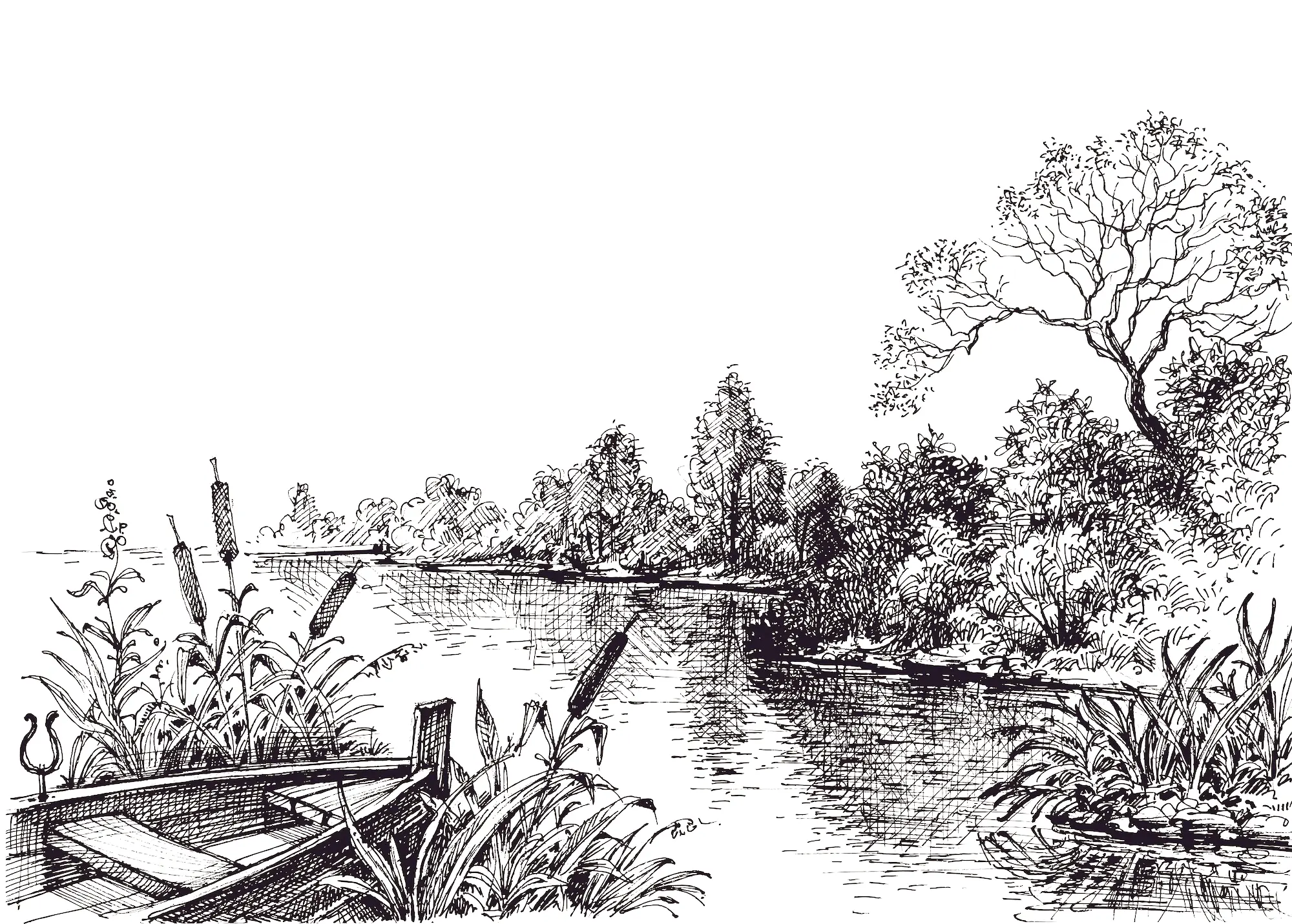Byron Karns has mussels on his muscles. On his right leg, there’s a tattoo of a zebra mussel; on the left, a tattoo of a threehorned wartyback. Karns, 63, also boasts a tattoo of the St. Croix and Namekagon Rivers, on his right foot, with ink that flows from his toes to his ankles—a scaled down map from the US Geological Survey. “I might have included a touch of the Mississippi [River] for context,” he says if he were to do it over again.
Citizen-Scientist Coalition Works to Protect Native Mussels on the St. Croix River
The river’s future, however, remains uncertain under a Supreme Court-gutted Clean Water Act


With its visible byssal threads—the strong fibers that bivalves like mussels and oysters use to attach to objects—Karns’s zebra mussel tattoo looks like it’s affixed itself to his right calf, a symbol of the invasive species’ relentless hold on the river as much as Karns’s own resolve to preserve its native mussel population.
For Karns, the tattoos represent the three decades he worked for the National Park Service (NPS), including 15 years as an aquatic biologist working to conserve the St. Croix River ecosystem and its extraordinarily diverse population of mussels.



Now retired, Karns is never far from the waterway. After diving the river between 20 to 60 days a year, he continues to dive regularly as an NPS volunteer for the same program that he ran for nearly a decade, working with his fellow volunteers, to find native mussels and “scrub them clean” of attached zebra mussels.
The St. Croix River flows 164 miles from Upper St. Croix Lake in Wisconsin’s Douglas County, south of Lake Superior, through Wisconsin and along the Minnesota-Wisconsin border to its confluence with the Mississippi River near Prescott, Wisconsin. Today, it’s considered the cleanest tributary on the Mississippi River, in large part due to its status for the past 50 years as a Wild & Scenic River. In 1968, the Upper St. Croix River became one of eight rivers in the United States protected under the National Wild & Scenic Rivers Act, enacted to preserve the country’s rivers and streams in their natural, free-flowing condition (the Lower St. Croix was added in 1972).
“We’re incredibly fortunate that the St. Croix and Namekagon Rivers are home to 41 native freshwater mussels,” says Katie Sickmann, Natural Resources Manager for the Wild Rivers Conservancy. “[The St. Croix] has a world class mussel population,” thanks at least in part to the Wild and Scenic designation.
With life-spans reaching up to 100 years, mussels are among the longest-living invertebrates, making them a window into history. “We still have that same mussel population that was here prior to European settlement,” says Sickmann. But that legacy is now under threat. While pristine, the river and its famed mussel population has been suffering. “We currently have five federally endangered mussel species in the St. Croix River.” Among those is the winged mapleleaf. State agencies in Minnesota and Wisconsin have listed 17 mussel species in the river as endangered.
The Ripple Effect of Environmental Harm
Zebra mussels are believed to have been introduced to the United States in 1988 in Detroit’s Lake St. Clair, brought there in ballast water—water carried by ships without cargo to help them remain stable. Since then, zebra mussels have traveled hundreds of miles more to the St. Croix and into the Mississippi watersheds by attaching themselves to boats or floating with the current.

Rather than living burrowed in a river bed, zebra mussels anchor themselves by attaching to whatever is nearby—whether a rock, a dock or another mussel—allowing them to outcompete native mussels, fish and other species for food and habitat. Zebra mussels reduce oxygen at the bottom strata of a lake or river, suffocating native mussels. They also take over space natives might use and also, by attaching themselves to a native mussel, prevent it from moving and reproducing. The result: a decrease in the population of native mussels—a loss that “sends ripples through the system,” says Karns.
Another ripple about which river keepers and scientists are raising the alarm is the Supreme Court’s May ruling in Sackett v. EPA. The decision overturned the Biden administration’s definition of “waters of the United States,” or WOTUS, the term for the bodies of water that are regulated by the Clean Water Act. While all nine justices agreed the Biden administration’s definition was too broad, the court published four separate opinions that revealed a 5-4 split, with the conservative majority asserting that the Clean Water Act applies only to wetlands with a “continuous surface connection” to navigable waters like streams, lakes, oceans and rivers. On August 31, 2023, the EPA issued a final rule to amend the revised definition of WOTUS to conform to the Court’s decision.
By narrowing the definition of WOTUS to cover only adjoining wetlands, the court significantly curtailed the Environmental Protection Agency and Army Corps of Engineers’ authority to regulate and protect millions of acres of wetlands. The decision means that more than half the country’s wetlands—what scientists call the “earth’s kidneys” because of their ability to clean the water that flows through them—will no longer come under federal protection.
“Wetlands are a key component to the health of water on this planet. A human or a mussel doesn’t need to live in one to reap the unparalleled benefits they provide,” says Karns of the court’s decision. “Diversity and abundance of plants and critters in these systems is unmatched. In some wetlands, like fens, rare, unique and imperiled communities are found. They represent a precious part of our planet’s natural history. I believe the intention of the Clean Water Act was not the ‘Clean Continuously Flowing Water Act.’ ”
A ‘Last Hope’ for Endangered Species
Citizen-scientists like Karns bring needed muscle to the river—physical and intellectual. As he sees it, educating the public is key to the survival of the freshwater bivalve.
Similar to wetlands, native mussels are called the lungs and livers of our rivers. Not only are they a key food source for river animals, they also act as natural filtration systems that clean our rivers. A single mussel can filter up to 15 gallons of water a day, breathing life into waterways by removing pollutants such as algae, bacteria, silt and even metals.
Across the country, aquatic biologists and citizen-scientists like Karns work together to care for North America’s 300 freshwater mussel species. Considered a barometer of a river’s health, the continent’s mussels are in trouble. More than a third are listed as endangered or threatened. The causes range from invasive species like the zebra mussel, to climate change, water pollution and dams, which separate mussels from fish on which they depend for procreation. The Center for Biological Diversity calls freshwater mussels “the most endangered group of organisms in the United States.” Of the 23 species named extinct by the U.S. Fish and Wildlife Service in 2021, eight were mussels.

Other waterways and mussel populations throughout the country don’t enjoy the same protections as the St. Croix. For example, the Minnesota River—which flows 335 miles from the Minnesota-South Dakota border into the Mississippi watershed—was once home to 50 mussel species. Today, the Minnesota Department of Natural Resources lists 28 of those species as “extirpated, endangered, threatened or of special concern.” The Mississippi River, itself, which historically had more than 40 species of mussels, had nearly no mussels left by the 1800s. Thanks to repopulation efforts, the Mississippi is now home to 21 species and, according to NPS , could be a “last hope” for a number of endangered species, including the Higgen’s eye pearlymussel, which in 1976 was among the first freshwater mussels to receive federal protection.
Rivers Across the Nation Offer Signs and Lessons
Several hundred miles southwest of the St. Croix is the Raccoon River, a 31-mile tributary of the Des Moines River in central Iowa which is in the Mississippi watershed. In 2021, American Rivers, a national advocacy group focused on clean water and river health, declared the Raccoon River one of the nation’s most endangered rivers; the river absorbs nitrates and other pollution from more than 750 Concentrated Animal Feeding Operations (CAFOs) located in its watershed, drinking up the urine and feces of more than 11.7 million animals. This puts at risk more than half a million Des Moines-area residents who rely on the river for their drinking water supply. Despite spending $4 million dollars in 1991 to build one of the nation’s largest nitrate filtration systems, a 2021 investigation by Public Health Watch (PHW) found that “Iowa’s chemical-saturated agriculture continues to wreak havoc on Des Moines’ water supply.” Poor water quality also hurts taxpayer wallets: PHW’s investigation found that when nitrate levels are too high, it costs the Des Moines Water Works up to $10,000 a day to run the nitrate filtration system. Water bills increase annually by up to 10%.
Add drought conditions fueled by climate change to the mix, and the river has seen “increased outbreaks of toxic algae in the river, which harm ecosystem health, limit the ability of people to safely enjoy river recreation and contribute to the growing dead zone downstream in the Gulf of Mexico,” says Jen Kurth, a natural resources biologist with the Iowa Department of Natural Resources. Concerned about the river’s mussel population, in 2011 Kurth developed an “index of biotic integrity for mussels in Iowa,” a database that existed at the time only for fish. She found the general mussel population in the South Raccoon and the Middle Raccoon, both located above major dams, to be in poor health. Reports suggest at least six different species of mussels in the Middle Raccoon and four in the South Raccoon are endangered. The North Raccoon “is actually fairly decent for freshwater mussels in Iowa,” she says. “But, compared to the St. Croix, no river in Iowa is decent.”

Often, when the EPA can’t or won’t step in, protection of water falls on citizen scientists who actively monitor water quality. Local annual “snapshot” events hosted by groups such as the Watershed Foundation, encourage additional volunteers to come out and assess water quality; the data collected helps “drive action for clean water,” writes the foundation on its website.
It’s not just river keepers in the Mississippi watershed that are concerned about mussel populations. From Washington, D.C.’s Potomac and Anacostia Rivers to the Delaware River, the Bronx River in New York and waterways in Chicago, mussels are a topic not only of species preservation but pollution control: Mussels are being outsourced for river clean-ups.
Four years ago the Potomac Riverkeeper Network kicked off the 50 Million Mussel Project. Named the “Nation’s River,” by President George Washington, President Lyndon B. Johnson in 1965 called the heavily polluted Potomac “disgraceful.” It would be another seven years before the Clean Water Act was passed, in 1973, and another five decades before the clean-up efforts on the Potomac had restored the river’s water quality to a level that finally made it suitable to sustain a vibrant wild mussel population. Because the primary threat to mussel survival is sedimentation caused from stormwater runoff which can smother the mussel beds and block sunlight, it wasn’t until 2019 that Potomac Riverkeepers could launch their mussel project.
As with other mussel projects, the Potomac’s began with volunteers using their muscle to tend to baskets of bivalves floating above the river bottom; baskets are pulled up, brushed off, and re-submerged into the water column, preventing sediment buildup and suffocation. As conditions improve in waterways, like the Potomac, mussels are introduced to the river bottom to become self-sustaining and self-propagating.
Back in Wisconsin, Karns continues to celebrate the efforts of everyone from volunteers to scientists who seek to understand the threat posed by zebra mussels and to propagate species of mussels facing extinction, including the Winged mapleleaf and the Higgin’s eye pearlymussel. During a dive in September, regional directors, academics, researchers, field staff and managers came together recognize efforts over the last two decades. Some during the celebratory dive collected “ripe” winged maple females that reproduce in the fall to bring them to an off-site facility while others, like Karns, placed juvenile winged mapleleaf propagated in a USGS facility into the river to grow over the winter.
“If our winged mapleleaf mussels go away, that whole genetic strand of winged mapleleaf goes away,” says Sickmann. “And we have one of the last reproducing populations in the entire world. So it’s definitely an important species to help get back on its feet.”

Cari Shane is a Washington, D.C.-based freelance journalist who writes on subjects she finds fascinating—especially science, medicine and health. Cari’s work can be found in a wide variety of publications from The Washington Post Magazine to Scientific American.

Caroline Yang graduated from Tufts University in Boston, MA, and worked as an advertising account executive at Fallon before beginning her career as a professional photographer. She aims to create photographs that reflect the depth and complexities of the human experience, and bring understanding and connection to our communities. Her hope is to create images that tell a story and help facilitate engagement and unity. You can find her on Instagram at carolineyangphoto.
Have thoughts or reactions to this or any other piece that you’d like to share? Send us a note with the Letter to the Editor form.
Want to republish this story? Check out our guide.
More from Barn Raiser

Driftless Water Defenders Go on the Offensive in Iowa







